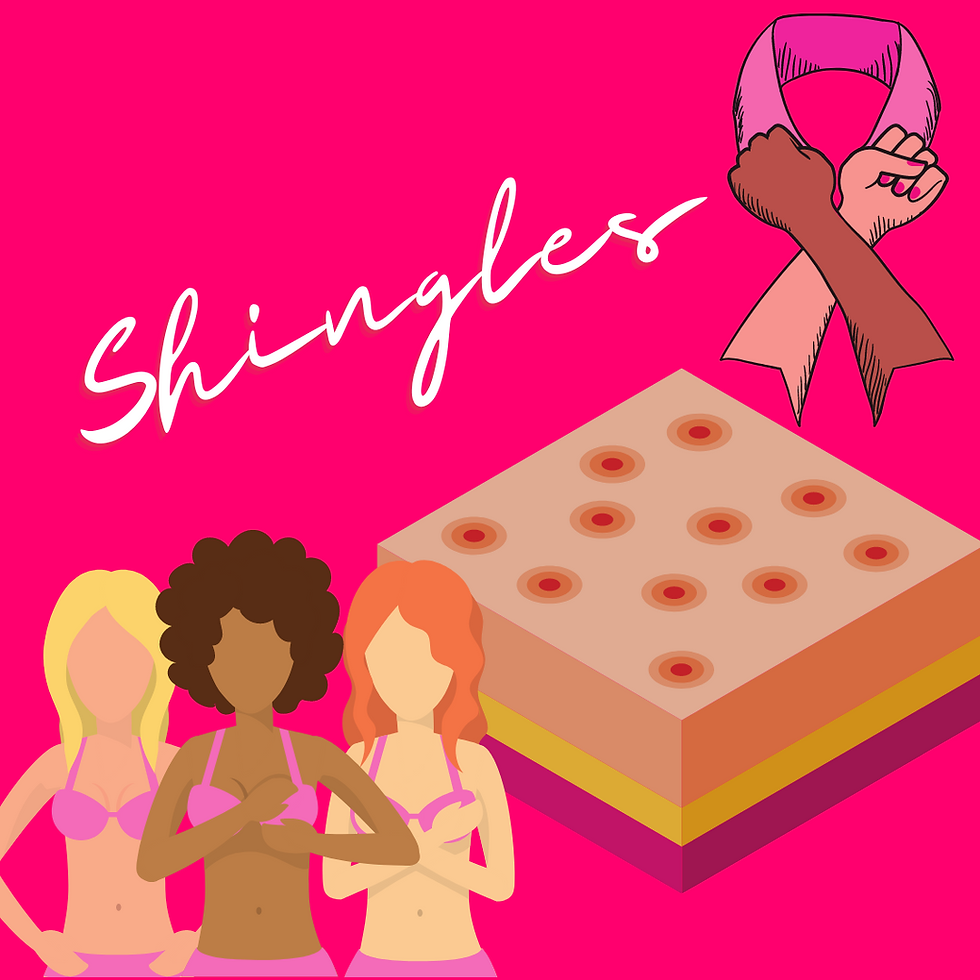Breast Cancer and Shingles
- Survivingbreastcancer.org

- May 21, 2021
- 3 min read

Breast cancer and shingles.
Is there a relationship? Studies indicate that there may be a correlation. Talk about one’s body multi-tasking in a most adversarial way! During a recent survivingbreastcancer.org virtual meet up, a number of the community stated they had developed shingles. The conversation stimulated much in the way of follow up.
What we do know: Shingles is caused by the same virus that causes chickenpox, also known as the varicella zoster virus. After a person has had chickenpox, the virus may remain in their body and become inactive. Years later, the virus can reactivate, causing shingles (herpes zoster).
According to the U.S. Centers for Disease Control and Prevention, nearly 30% of people in the United States will develop shingles, and about 1 million cases occur in the country each year.
Newly diagnosed cancer patients may be at increased risk for this most painful skin condition. Patients with a solid tumor, e.g., cancer in the breast had a 30% higher risk of shingles than people without cancer. “Among patients with solid tumors, the greater risk was largely associated with receiving chemotherapy treatment, rather than with the cancer itself” (Jiahui Qian, Journal of Infectious Diseases).
Can shingles cause breast cancer?
The shingles virus has never been connected to cancer, but it has the potential to be confused with rashes that are linked with cancer cells. Shingles can develop on or near the breast. Interestingly, shingles favors the torso. When presented on the breast, symptoms typically follow this progression:
Very sensitive skin, often accompanied by pain or numbness
Within a week a red rash develops
With this rash blisters develop
Blisters break to form scabs
After several weeks the blisters heal
Unfortunately nerve pain can continue for up to one year
What about a shingles vaccine?
Vaccines are available, but due to a lack of data, these vaccines are not yet recommended for use in the cancer patient group. Also in development is a shingles vaccine that uses an inactivated form of the virus.
These advances suggest that vaccines show promise as a way to prevent shingles and its complications in cancer patients. As always, we recommend those diagnosed with breast cancer consult your oncologist at the first sign of shingles.
The shingles vaccine is recommended for adults aged older than 50 years; however, Zostax, a live-virus vaccine, may not be suitable for patients with immunodeficiency or immunosuppression, including those with cancer. The vaccine combines glycoprotein E with an adjuvant system that enhances immunologic response. Read More.
A 65-year-old female patient with breast pain, severe edema, irritation and itching in the left breast was admitted to the emergency department.
This patient had a history of breast cancer four years previously, which metastasized to the lungs and lymph nodes on her neck. This patient was treated with radiotherapy and chemotherapy and total mastectomy for several years. The breast often appeared swollen, erythematous and red, or inflamed. Read More.
The large prospective study examined the risk of shingles before and after a cancer diagnosis and across a range of cancer types among more than 240,000 adults in Australia between 2006 and 2015. The risk for shingles was 30 percent higher in those with solid organ cancers, such as cancer located in the lung, breast, prostate or other organ, compared with someone without cancer. Read More.
In the United States, Shingrix was approved by the Food and Drug Administration (FDA) in 2017 and is preferred to Zostavax. Studies suggest that Shingrix offers protection against shingles for more than five years. Shingrix is a nonliving vaccine made of a virus component. It is given in two doses, with two to six months between doses. Shingrix is approved and recommended for people age 50 and older, including those who've previously received Zostavax or had shingles. Read More.
.png)
.png)














Comments